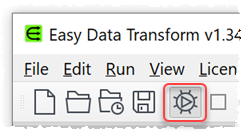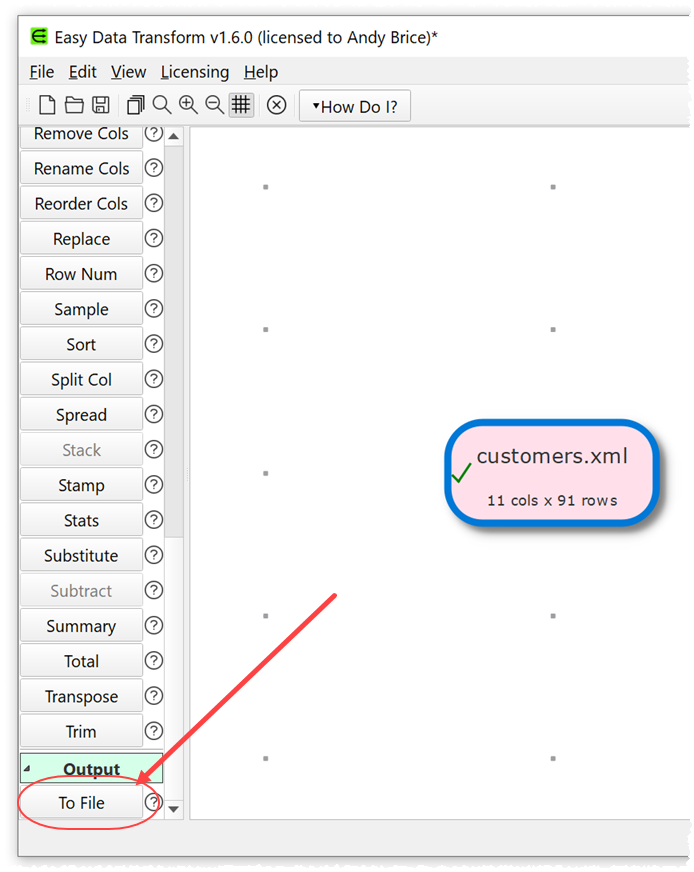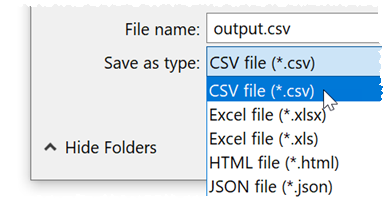XML and CSV formats are both widely used for storing and exchanging data, but have very different structures. XML is markup text structured in the form of a tree and CSV is escaped text structured as a table. However you can easily convert XML to CSV format with Easy Data Transform:
- Download and install Easy Data Transform on your PC or Mac, if you haven’t done so already. It will only take a minute. There is a fully functional free trial and you don’t have to give us your email or sign up to anything.
- Start Easy Data Transform. Make sure the Auto Run button is pressed in.

- Drag the XML file you wish to convert onto Easy Data Transform. Typically it will have the extension .xml. A pink input item will be added.
- Note that in the Right pane the XML data has has been ‘flattened’ into a table, suitable for output to a CSV file. The nodes below the XML ‘root’ node are mapped to rows in Easy Data Transform.
- You can set the Format drop-down in the Right pane to Long or Wide, depending on whether you want the tables to have more rows or more columns.
- Ensuring the pink input item is selected, click the To File button in the Left pane (scroll to the bottom of the Left pane).

- A window will appear. Set the new file name and location. Select CSV file as the file type.

- A green output item is added and selected.

- The CSV file is created immediately at the chosen location, no need to ‘run’ anything.
Example XML input:
<?xml version="1.0" encoding="UTF-8"?>
<root>
<record>
<CategoryID>1</CategoryID>
<CategoryName>Beverages</CategoryName>
<In_stock>true</In_stock>
</record>
<record>
<CategoryID>2</CategoryID>
<CategoryName>Condiments</CategoryName>
<In_stock>false</In_stock>
</record>
<record>
<CategoryID>3</CategoryID>
<CategoryName>Confections</CategoryName>
<In_stock>true</In_stock>
</record>
</root>
Example CSV output:
CategoryID,CategoryName,In_stock
1,Beverages,true
2,Condiments,false
3,Confections,true
The dot (‘.’) character is used to show nesting of XML values and XML attribute values start with an underscore (‘_’). For example:
<?xml version="1.0" encoding="UTF-8"?>
<root>
<record carb="2" cholesterol="5" fiber="0"
name="Avocado Dip" protein="1" sodium="210">
<minerals>
<ca>0</ca>
<fe>0</fe>
</minerals>
<vitamins>
<a>0</a>
<c>0</c>
</vitamins>
</record>
</root>
Will be ‘flattened’ into CSV as:
_carb,_cholesterol,_fiber,_name,_protein,_sodium,minerals.ca,minerals.fe,vitamins.a,vitamins.c
2,5,0,Avocado Dip,1,210,0,0,0,0
You can use a Rename Cols transform if you want to rename any of the columns before output.
If you have a large number of files to convert you can do it using batch processing.
You can do all this conversion offline. You do not need an Internet connection.
As well as changing file format, Easy Data Transform also allows you to combine 73 transforms (such as merge, dedupe and filter) to quickly and easily create simple or complex data transformations.

 Windows Download
Windows Download
 Mac Download
Mac Download